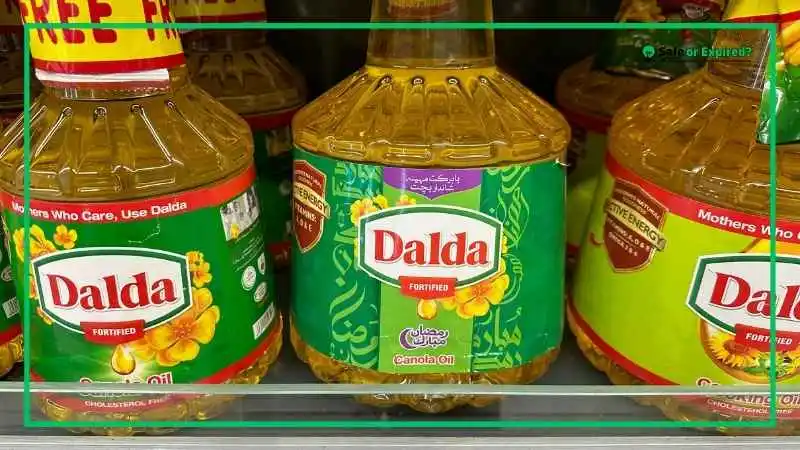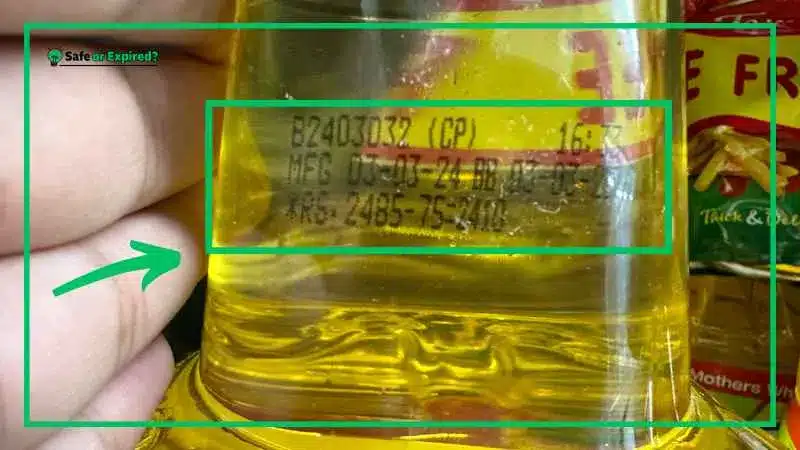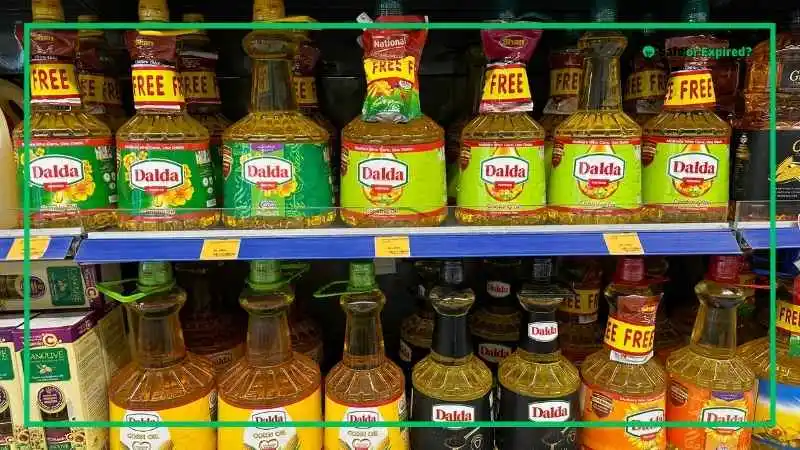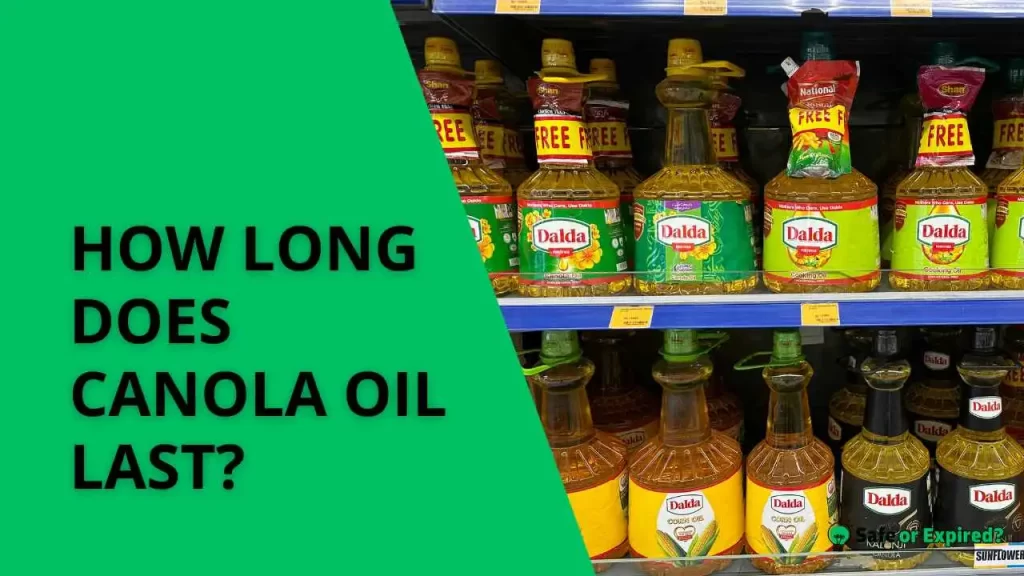“How long does canola oil last?” is a question many people have. The answer is straightforward – Unopened, it can last up to two years, while opened bottles are good for about a year. But the problem is this shelf life can vary because of some factors, which I’m discussing in detail here.
As a bonus, I’m also sharing five tips to keep canola oil fresh for a long time. Keep reading.
How Long Does Canola Oil Last?
Canola oil, when stored properly, lasts about one to two years. Once you open it, the clock starts ticking faster. Keeping it in a cool, dark pantry can make it last about a year. But if you refrigerate it, you can stretch that time to about two years.
Let’s break it down.
How Long Does Canola Oil Last Unopened?

Unopened canola oil stays fresh for about two years from the manufacturing date. This is because it’s sealed and protected from air, light, and moisture, all of which can make it go bad faster. So, if you haven’t broken the seal yet, your canola oil is probably good to go for a while.
How Long Does Canola Oil Last in the Refrigerator?
Once you open canola oil, storing it in the refrigerator can keep it fresh for up to two years. But remember, refrigerating oil can make it look cloudy. Don’t worry; it’s still good to use. Just let it warm up a bit, and it will clear up.
How Long Does Canola Oil Last on the Counter?
Storing opened canola oil on the counter or in a pantry is okay, too. In this case, it will last about a year. The key is to keep it in a cool, dark pantry. We don’t want any heat or light, as both can speed up the spoilage process, so avoid placing it near the stove or in a sunny spot.
How Long Does Canola Oil Last in the Freezer?
Freezing canola oil isn’t very common, but you can do it. In the freezer, canola oil can last indefinitely. However, the texture might change, and it can become cloudy and thick. Thawing it will bring back its usual consistency.
If you choose this method, just make sure to use a freezer-safe container to avoid any mess.
Here’s a shelf life table of canola oil to sum up the details:
| Unopened | Opened | |
| Counter | 2 years | Two years |
| Refrigerator | One year | 1 to 2 years |
| Freezer | Indefinite | Indefinite |
When buying canola oil, check the expiration date on the bottle. Choose one with the farthest date to ensure maximum freshness. The EXP or best before date is usually mentioned on the bottle.

Also, go for smaller bottles if you don’t use a lot of oil. This way, you’ll use it up before it goes bad.
Understanding the shelf life of canola oil is one thing, but what about other staples like vegetable oil? Find out how to keep it in top condition by reading about ways to maintain the freshness of vegetable oil.
What Are the Factors That Affect Canola Oil Shelf Life?
Factors affecting canola oil shelf life include exposure to light, heat, and air, which can accelerate oxidation. Proper storage in a cool place and tightly sealed containers helps maintain freshness. Additionally, the presence of antioxidants and low levels of free fatty acids can extend shelf life.
Storage Conditions
Storage conditions play a huge role in how long canola oil stays fresh. Keeping your canola oil in a dark place like a pantry or cupboard helps it last longer. Heat and light speed up the spoilage process, so avoid storing it near the stove or in a sunny spot. When you store canola oil properly, you protect it from going rancid quickly.
A fridge can help extend the shelf life of opened canola oil, but it might make the oil look cloudy. This cloudiness goes away once the oil warms up to room temperature. Freezing canola oil isn’t common, but it can be done if you want to store it for a very long time.
Just remember, freezing can change the oil’s texture and make it thicker.
Exposure to Light and Heat
Light and heat are enemies of canola oil. Exposure to light, especially sunlight, can cause the oil to spoil faster. The UV rays break down the oil’s molecules, leading to rancidity. To prevent this, always keep the oil in a dark bottle or store it in a cupboard away from light.
Heat also speeds up the oxidation process, making the oil go bad more quickly. That’s why you should never store canola oil near the stove or other heat sources. The ideal temperature for storing canola oil is between 50°F and 70°F.
Keeping it cool and dark helps maintain its quality and flavor for a longer time.
Opened vs. Unopened
Whether your canola oil is opened or unopened makes a big difference in its shelf life. Unopened canola oil can stay good for up to two years because it’s sealed from air and moisture. Once you open it, the oil is exposed to air, which starts the oxidation process.
This is why opened canola oil usually lasts about a year if stored on the counter or in the pantry.
Container Type
The type of container in which you store your canola oil matters a lot. Dark glass bottles are the best because they protect the oil from light. Plastic bottles are okay, but they don’t offer as much protection from light and can sometimes leach chemicals into the oil over time.
If you buy canola oil in a large container, consider transferring some of it into a smaller bottle for daily use. This way, you minimize the amount of air exposure each time you open the container.
Always make sure the bottle is clean and dry before you pour oil into it. Using the right container helps keep your canola oil fresh and safe to use.
Quality of Oil
The quality of the canola oil itself affects how long it will last. High-quality, cold-pressed canola oil tends to have a shorter shelf life than refined canola oil because it contains more natural compounds that can spoil.
However, refined canola oil, which has been processed to remove impurities, usually lasts longer.
Always check the expiration date when buying canola oil and opt for the freshest bottle available. Buying smaller bottles if you don’t use a lot of oil can also help ensure you use it up before it goes bad. High-quality oil stored properly will last longer and maintain its flavor better.
How Long Does Canola Oil Last After Expiration Date? Know the Details
Canola oil can last a bit past its expiration date, but it depends on how you store it. If it smells and tastes okay, it’s likely still good to use for a few months. Canola oil can last up to 1-2 years past its expiration date.
Once opened, it is best to use it within six months.
Expiration dates can be confusing. They don’t mean the oil goes bad right after that date. It’s more like a guideline for peak freshness. If you stored your canola oil in a dark place and kept it sealed well, it might be good for a few months after the expiration date.
But remember, once you open it, the oil is exposed to air, and that starts the clock ticking faster.
How Long Does Canola Oil Last in a Deep Fryer?
In a deep fryer, canola oil typically lasts for 8-10 uses or about 1-2 weeks. However, it’s crucial to regularly filter the oil to remove food particles, and discard it if it becomes dark, foamy, or develops an off odor.
It all depends on how often and what you’re frying.
Usage Frequency
How often you use your deep fryer affects the oil’s lifespan. If you’re frying every day, the oil breaks down faster. Regular use means you’ll need to change it more often, maybe every week. If you only use the fryer occasionally, the oil can last a bit longer, up to two weeks.
Types of Food
What you fry matters, too. Foods with heavy breading or high water content make the oil break down faster. Frying foods like chicken wings, french fries, or fish introduce more particles into the oil. These particles can burn and create off flavors, making the oil spoil quicker. To make your oil last longer, try to shake off excess breading and moisture before frying.
Oil Maintenance
Maintaining your oil can extend its life. After each use, let the oil cool and then strain it to remove food particles. This helps keep the oil clean and reduces the risk of burning. Some fryers come with built-in filters, but you can also use a cheesecloth. Regularly topping off the oil with fresh oil can also help maintain quality.
Does Canola Oil Spray Expire?
Just like regular canola oil, canola oil spray can go bad. The expiration date on the can tells you when the product is at its best. After that date, the oil might start to lose its quality. The spray mechanism can also become less effective over time, making it harder to use.
Does Wesson Canola Oil Expire?
Yes, Wesson canola oil does expire. Like all canola oils, Wesson canola oil has a shelf life. It is best used within two years of the manufacturing date. Unopened bottles can last up to this period when kept in a dark place.
Once you open it, the shelf life decreases, usually lasting about a year if stored in the pantry.
How To Know if Canola Oil Is Bad? Key Signs
To know if canola oil is bad, check for odors, such as a sour or rancid smell. Observe the oil’s color; it should be clear and light yellow, not dark or cloudy. Taste a small amount if unsure; a bitter or unpleasant taste indicates spoilage.
Additionally, check for any changes in texture, such as thickening or clumping.
Smell
One of the easiest ways to tell if canola oil has gone bad is by how it smells. People often ask, “Does canola oil smell?” Well, fresh canola oil has a mild, neutral scent. If your canola oil starts to smell sour, it’s a clear sign that it’s no longer good.
So, What does rancid canola oil smell like? Rancid oil smells like old paint or even crayons. It’s not a pleasant smell and definitely not something you’d want in your food. Always give your oil a quick sniff before using it to make sure it’s still fresh.
Taste
Taste is another indicator of whether canola oil is bad. Fresh canola oil has a light, slightly nutty flavor. If it tastes bitter or off, it’s time to throw it away. You don’t need to taste a lot, just a tiny bit.
If you’re unsure, try a small amount with a piece of bread. If the oil tastes strange or unpleasant, don’t use it. Cooking with rancid oil can ruin the flavor of your dishes and might even give you a stomach ache.
Appearance
The appearance of canola oil can also tell you if it’s gone bad. Fresh canola oil is pale yellow and clear. If it has turned darker or looks cloudy, it’s probably spoiled. Sometimes, you might see particles floating in the oil, which is another sign that it’s time to replace it.
Always check the color and clarity of your oil before using it. Keeping an eye on its appearance can help you catch spoilage early and avoid using bad oil in your cooking.
Expiration Date
While the expiration date isn’t the only factor, it’s a good guideline. That’s why I always suggest checking the expiration date on the bottle. If it’s past the date, inspect the oil carefully for any signs of spoilage like smell, taste, and appearance.
Using oil past its expiration date can be risky, as it might not be of its best quality. It’s always better to be safe and use fresh oil.
Can Expired Canola Oil Make You Sick?
Using expired canola oil can cause minor stomach issues and spoil the taste of your food. While it’s not typically dangerous, rancid oil can contain harmful compounds that may have long-term health effects.
Stomach Issues
Eating expired canola oil can lead to minor stomach problems. If the oil has gone rancid, it might cause you to feel queasy or give you a stomach ache. The bad taste and smell can be off-putting, and your body might react to these spoiled compounds.
It’s similar to eating food that’s a bit past its prime – not necessarily dangerous, but definitely uncomfortable. To avoid this, always check your oil before using it.
Spoiled Food Taste
One of the most noticeable effects of using expired canola oil is the taste it gives your food. Rancid oil has a bitter, unpleasant flavor that can ruin your dish. Even if the oil doesn’t make you sick, it can make your meal taste bad.
Fresh oil should have a neutral or slightly nutty flavor, so if you notice a strange taste, it’s best to discard the oil. Keeping your oil fresh ensures your food tastes its best.
Long-term Health Effects
While using expired canola oil occasionally might not cause immediate harm, there could be long-term health effects from regular consumption. Rancid oils contain harmful compounds like peroxides and aldehydes that form during the spoilage process. These compounds can cause chronic diseases if consumed regularly.
It’s always better to use fresh oil to avoid these potential health risks. Maintaining a healthy diet with fresh ingredients is key to long-term wellness.
5 Storage Tips for Prolonging Canola Oil’s Shelf Life
To prolong canola oil’s shelf life, store it in a cool, dark place, keep the bottle tightly sealed, and avoid exposing it to heat and light. Refrigeration can help extend its freshness.
Store in a Cool, Dark Place

Keeping your canola oil in a cool, dark place is essential for maintaining its freshness. Light and heat accelerate the spoilage process, causing the oil to go rancid faster. A pantry or a cupboard away from the stove is ideal.
By storing canola oil properly, you can ensure it stays fresh for a longer time.
Keep the Bottle Tightly Sealed
Air is another factor that can cause canola oil to spoil. Every time you open the bottle, air gets in, and oxidation starts. To minimize this, always make sure the bottle is tightly sealed after each use. This simple step can significantly prolong the oil’s shelf life by reducing its exposure to air.
If you pour canola oil into a smaller container for easier use, make sure the new container is also airtight. Proper sealing keeps the oil fresher longer.
Avoid Heat and Light
Avoiding heat and light is crucial for keeping your canola oil fresh. Heat can come from various sources in the kitchen, like the stove, oven, or even direct sunlight. When canola oil is exposed to heat, it can start to break down. Light, especially UV light, can also cause the oil to degrade.
That’s why it’s best to store canola oil in a dark glass bottle or a container that keeps out light. This way, you protect the oil from harmful elements that can shorten its shelf life.
Refrigerate After Opening
Refrigerating canola oil after opening can help extend its shelf life. However, remember that refrigeration can cause the oil to become cloudy. This cloudiness doesn’t mean the oil has gone bad; it’s just the fats solidifying in the cold.
Once you bring the oil back to room temperature, it will clear up. Storing opened canola oil in the fridge is a great way to make it last longer without compromising its quality.
Use Proper Containers
The type of container you use for storing canola oil matters. Dark glass bottles are the best because they protect the oil from light. Plastic bottles are okay, but they don’t offer as much protection and can sometimes leach chemicals into the oil over time.
If you buy canola oil in a large container, consider transferring some of it into a smaller, dark glass bottle for daily use. This minimizes the amount of air exposure each time you open the container, helping to keep the oil fresh.
Using the right container is a simple but effective way to extend the shelf life of your canola oil.
If you’re managing the shelf life of canola oil, you might also be curious about other oils like avocado oil. Learn how to extend its freshness with this guide on keeping avocado oil fresh.
Conclusion
Properly storing canola oil is key to maintaining its freshness and flavor. Here’s a quick recap:
- Unopened canola oil lasts up to two years.
- Opened canola oil lasts about a year if stored properly.
- Store oil in a cool, dark place to extend its shelf life.
- Refrigeration helps keep the canola oil fresh for longer.
- Always check for signs of spoilage like smell, taste, and color.
Now, you can enjoy fresh and safe canola oil in all your cooking. Happy cooking!

